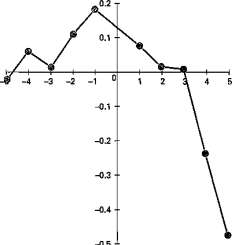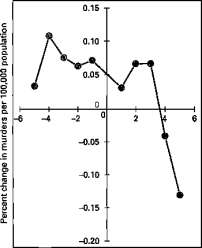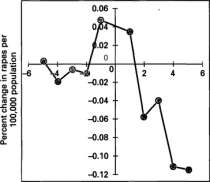More Guns Less Crime (21 page)
Read More Guns Less Crime Online
Authors: John R. Lott Jr
Tags: #gun control; second amendment; guns; crime; violence

One of the central arguments both in the original paper and in this book is that the size of the deterrent effect is related to the number of permits issued, and it takes many years before states reach their long-run level of permits. Again, the figures in chapter 4 illustrate this quite clearly.
I did not expect the number of permits to change equally across either counties or states. A major reason for the larger effect on crime in the more urban counties was that in rural areas, permit requests already were being approved; hence it was in urban areas that the number of permitted concealed handguns increased the most.
A week later, in response to a column that I published in the Omaha World-Herald, 20 Mr. Webster modified this claim somewhat:
Lott claims that his analysis did not assume an immediate and constant effect, but that is contrary to his published article, in which the vast majority of the statistical models assume such an effect. (Daniel W. Webster, "Concealed-Gun Research Flawed," Omaha World-Herald, March 12, 1997; emphasis added.)
When one does research, it is most appropriate to take the simplest specifications first and then gradually make things more complicated. The simplest way of doing this is to examine the mean crime rates before and after the change in a law. Then one would examine the trends that existed before and after the law. This is the pattern that I followed in my earlier work, and I have followed the same pattern here. The bottom line should be, How did the different ways of examining the data affect the results? What occurs here is that (1) the average crime rate falls after the nondiscretionary concealed-handgun laws are adopted; (2) violent-crime rates were rising until these laws were adopted, and they fell dramatically after that; and (3) the magnitude of the drops, both across counties and states and over time, corresponds to the number of permits issued.
4 When were these concealed-handgun laws adopted in different states?
Lott and Mustard also use incorrect dates of shall-issue law implementation in their analyses. For example, they claim that Virginia adopted its
shall-issue law in 1988 Some populous counties in Virginia continued
to issue very few permits until 1995 (after the study period), when the state eliminated this discretion. Lott and Mustard identify 1985 as the year in which Maine liberalized its concealed-carry policy. It is unclear why they chose 1985 as the year of policy intervention, because the state changed its concealed-carry law in 1981, 1983, 1985, 1989, and 1991. (Webster, "Claims," p. 3; see also Daniel W Webster, "Concealed-Gun Research Flawed," Omaha World-Herald, March 12, 1997; cited hereafter as Webster, "Flawed.")
I do think that Virginia's 1988 law clearly attempted to take away local discretion in issuing permits, and, indeed, all but three counties clearly complied with the intent of the law. However, to satisfy any skeptics, I examined whether reclassifying Virginia affected the results: it did not. The 1988 law read as follows:
The court, after consulting the law-enforcement authorities of the county or city and receiving a report from the Central Criminal Records Exchange, shall issue such permit if the applicant is of good character, has demonstrated
THE POLITICAL AND ACADEMIC DEBATE/133
a need to carry such concealed weapon, which need may include but is not limited to lawful defense and security, is physically and mentally competent to carry such weapon, and is not prohibited by law from receiving, possessing, or transporting such weapon [emphasis added]. 21
As with Virginia, I relied on a study by Clayton Cramer and David Kopel to determine when Maine changed its law to a nondiscretionary law. Maine enacted a series of changes in its law in 1981, 1983, 1985, and 1991. The 1985 law did not completely eliminate discretion, but it provided the foundation for what they then considered to be a switch to a de facto shall-issue regime, which was upheld in a number of important state court decisions. 22 The bottom line, however (again, as with Virginia), is that reclassifying Maine (or even eliminating it from the data set) does not change the results much.
5 Should robbery be the crime most affected by the adoption of the nondiscretionary law?
Shall-issue laws were adopted principally to deter predatory street crime, the most common example of which is robbery by a stranger. But [the] results indicate that shall-issue laws had little or no effect on robbery rates. Instead the strongest deterrent effects estimated were for rape, aggravated assault, and murder. (Webster, "Claims," p. 3)
Is it credible that laws that allow citizens to carry guns in public appear to have almost no effect on robberies, most of which occur in public spaces, yet do reduce the number of rapes, most of which occur outside of public spaces within someone's home. (Jens Ludwig, speaking on Morning Edition, National Public Radio, 10:00 a.m. ET December 10, 1996.)
I have two responses. First, as anyone who has carefully read this book will know, it is simply not true that the results show "little or no effect on robbery rates." Whether the effect was greater for robbery or other violent crimes depends on whether one simply compares the mean crime rates before and after the laws (in which case the effect is relatively small for robbery) or compares the slopes before and after the law (in which case the effect for robbery is the largest).
Second, it is not clear that robbery should exhibit the largest impacts, primarily because the term robbery encompasses many crimes that are not street robberies. For instance, we do not expect bank or residential robberies to decrease; in fact, they could even rise. Allowing law-abiding citizens to carry concealed handguns makes street robberies more difficult,
and thus may make other crimes like residential robbery relatively more attractive. Yet not only is it possible that these two different components of robbery could move in opposite directions, but to rank some of these different crimes, one requires information on how sensitive different types of criminals are to the increased threat.
Making claims about what will happen to different types of violent crimes is much more difficult than predicting the relative differences between, say, crimes that involve no contact with victims and crimes that do. Even here, however, some of these questions cannot be settled a priori. For example, when violent crimes decline, more people may feel free to walk around in neighborhoods, which implies that they are more likely to observe the illegal actions of strangers. 23 Criminals who commit violent crimes are also likely to commit some property crimes, and anything that can make an area unattractive to them will reduce both types of crime.
6 Do concealed-handgun laws cause criminals to substitute property crimes for rape?
Lott and Mustard argue that criminals, in response to shall-issue laws, substitute property crimes unlikely to involve contact with victims. But their theory and findings do not comport with any credible criminological theory because theft is the motive for only a small fraction of the violent crimes for which Lott and Mustard find shall-issue effects. It is difficult to rationalize why a criminal would, for example, steal a car because he felt deterred from raping or assaulting someone. (Webster, "Claims," p. 4. See also Jens Ludwig, "Do Permissive Concealed-Carry Laws Reduce Violent Crime?" Georgetown University working paper, October 8, 1996, p. 19, hereafter cited as Ludwig, "Permissive Concealed-Carry Laws")
No one believes that hard-core rapists who are committing their crimes only for sexual gratification will turn into auto thieves, though some thefts do also involve aggravated assault, rape, or murder. 24 Indeed, 16 percent of murders in Chicago from 1990 to 1995 occurred in the process of a robbery. 25 What is most likely to happen, however, is that robbers will try to obtain money by other means such as auto theft or larceny. Although it is not unusual for rape victims to be robbed, the decline in rape most likely reflects the would-be rapist's fear of being shot.
I am also not completely clear on what Webster means when he says that "theft is the motive for only a small fraction of violent crimes," since robbery accounted for as much as 34 percent of all violent crimes committed during the sample between 1977 and 1992 (and this excludes robberies that were committed when other more serious crimes like murder or rape occurred in connection with the robbery).
THE POLITICAL AND ACADEMIC DEBATE/135
7 Comparing crime rates for two to three years before nondiscretionary laws go into effect with crime rates for two to three years after the passage of such laws
If right-to-carry laws have an immediate, substantial impact on the crime rates, the coefficients on the right-to-carry laws immediately after the enactment of the law should be substantially different from those immediately preceding the law's enactment. To test formally for the impact of right-to-carry laws, we see if the sum of the coefficients for two to three years prior to adoption is significantly different from the sum for two and three years following adoption.... Only in the murder equation do our findings agree with Lott and Mustard. In contrast to Lott and Mustard, we find evidence that robberies and larcenies are reduced when right-to-carry laws are passed and no evidence of an impact on rape and aggravated assaults. (Dan Black and Daniel Nagin, "Do 'Right-to-Carry' Laws Deter Violent Crime?" Carnegie-Mellon University working paper, October 16, 1996, p. 7)
Instead of the approach used earlier in this book (a simple time trend and time trend squared for the number of years before and after the concealed-handgun laws) Black and Nagin use ten different variables to examine these trends. Separate variables were used for the first year after the law, the second year after the law, the third year after the law, the fourth year after the law, and five or more years after the law. Similarly, five different variables were used to measure the effects for the five years leading up to the adoption of the law. They then compare the average coefficient values for the variables measuring the effects two to three years before the law with the average effect for the variables two to three years after the law.
A quick glance at figures 7.1 to 7.5, which plot their results, will explain their findings. Generally, the pattern is very similar to what we reported earlier. In addition, as crime is rising right up until the law is adopted and falling thereafter, it is not surprising that some values when the crime rate is going down are equal to those when it was going up. It is the slopes of the lines and not simply their levels that matter. But more generally, why choose to compare only two to three years before and after to look for changes created by the law. Why not use all the data available?
Examining the entire period before the law versus the entire period after produces the significant results that I reported earlier in the book. Alternatively, one could have chosen to analyze the differences in crime rates between the year before the law went into effect and the year after, but one would hope that if deviations are made from any simple rule, some rationale for doing so would be given.

-0.5
Years before and after the adoption of nondiscretionary concealed-handgun law
Figure 7.1. Average year-dummy effects for violent crimes, using Black's and Nagin's "full sample"

Years before and after the adoption of the law
Figure 7.2. The effect of concealed-handgun laws on murder, using Black's and Nagin's "full sample"
THE POLITICAL AND ACADEMIC DEBATE/137
